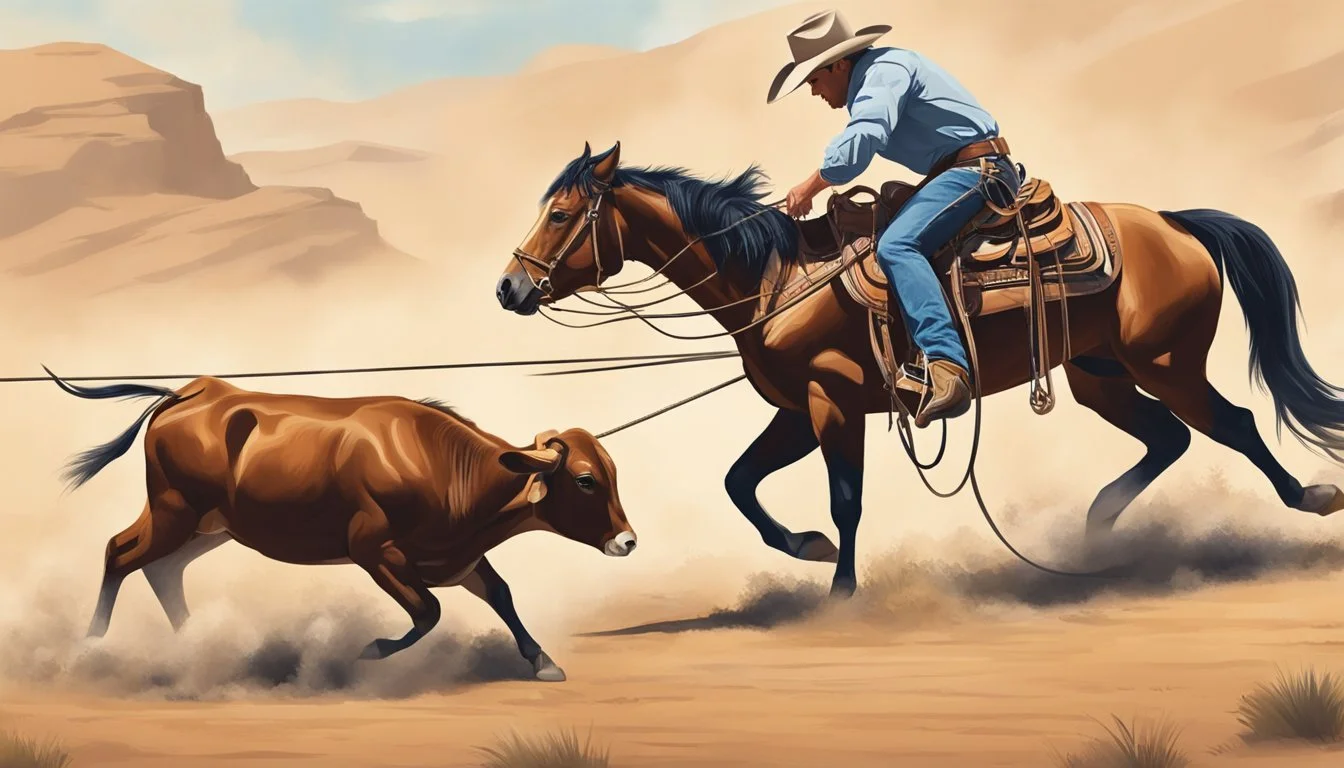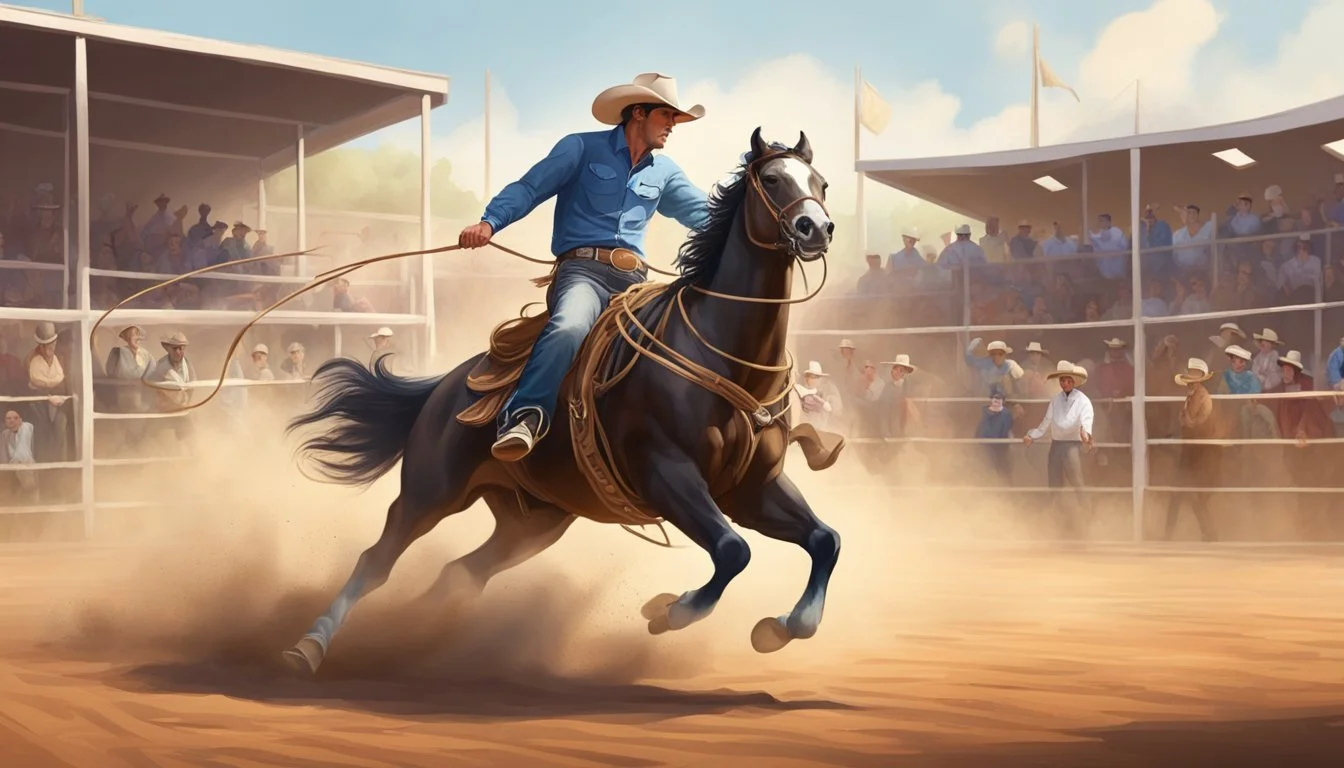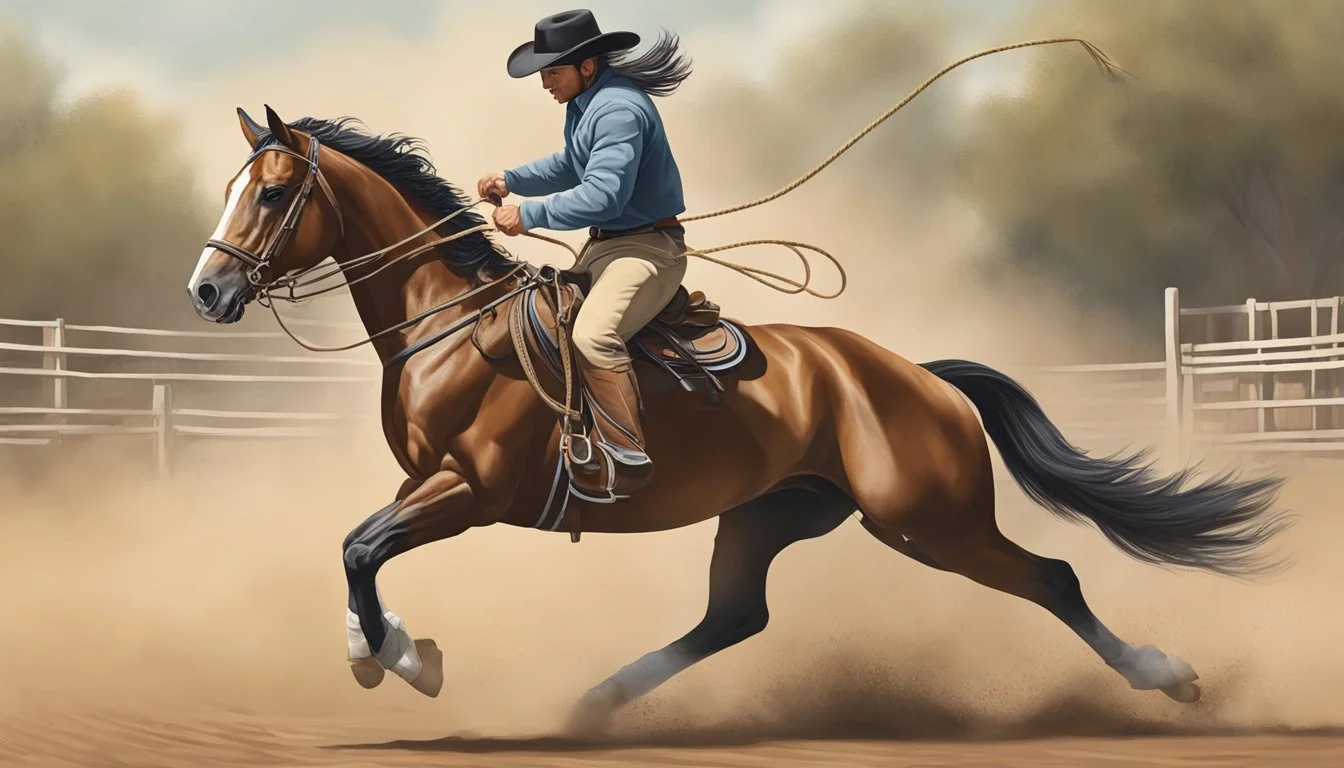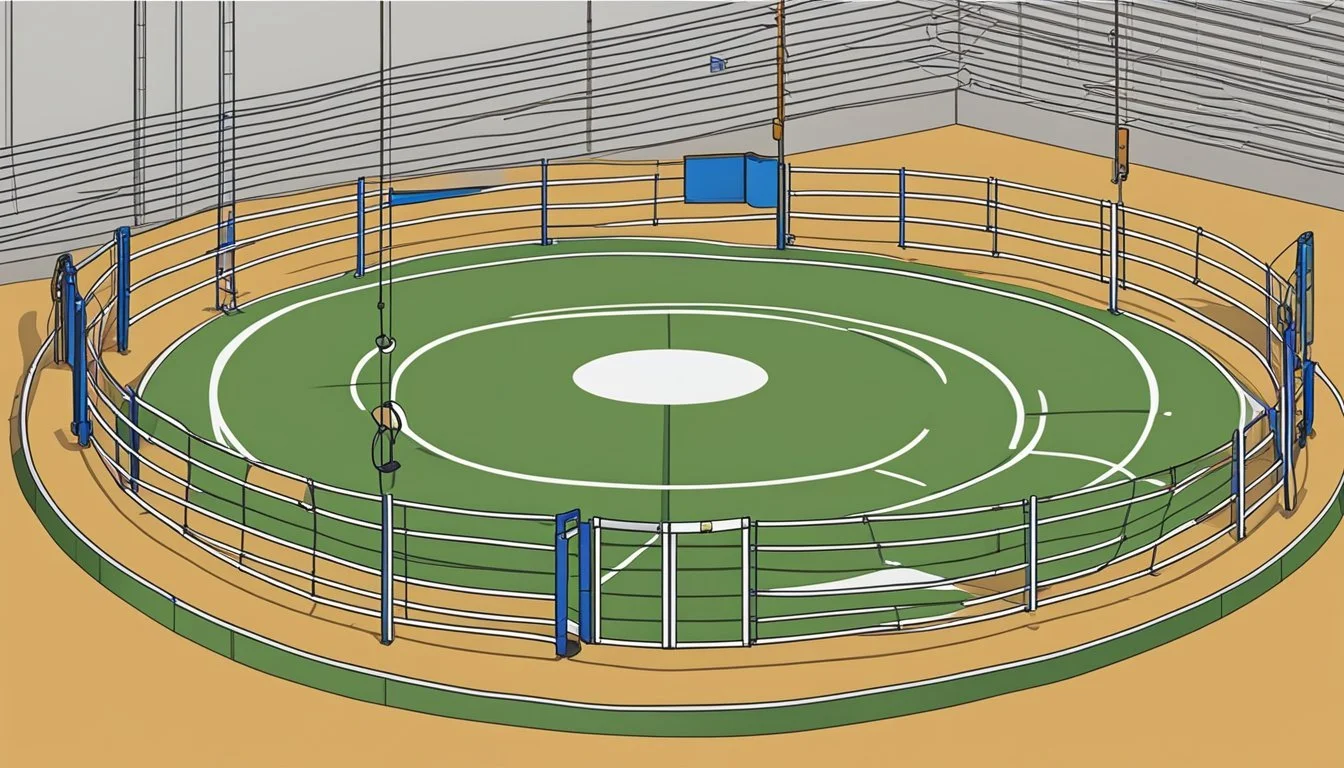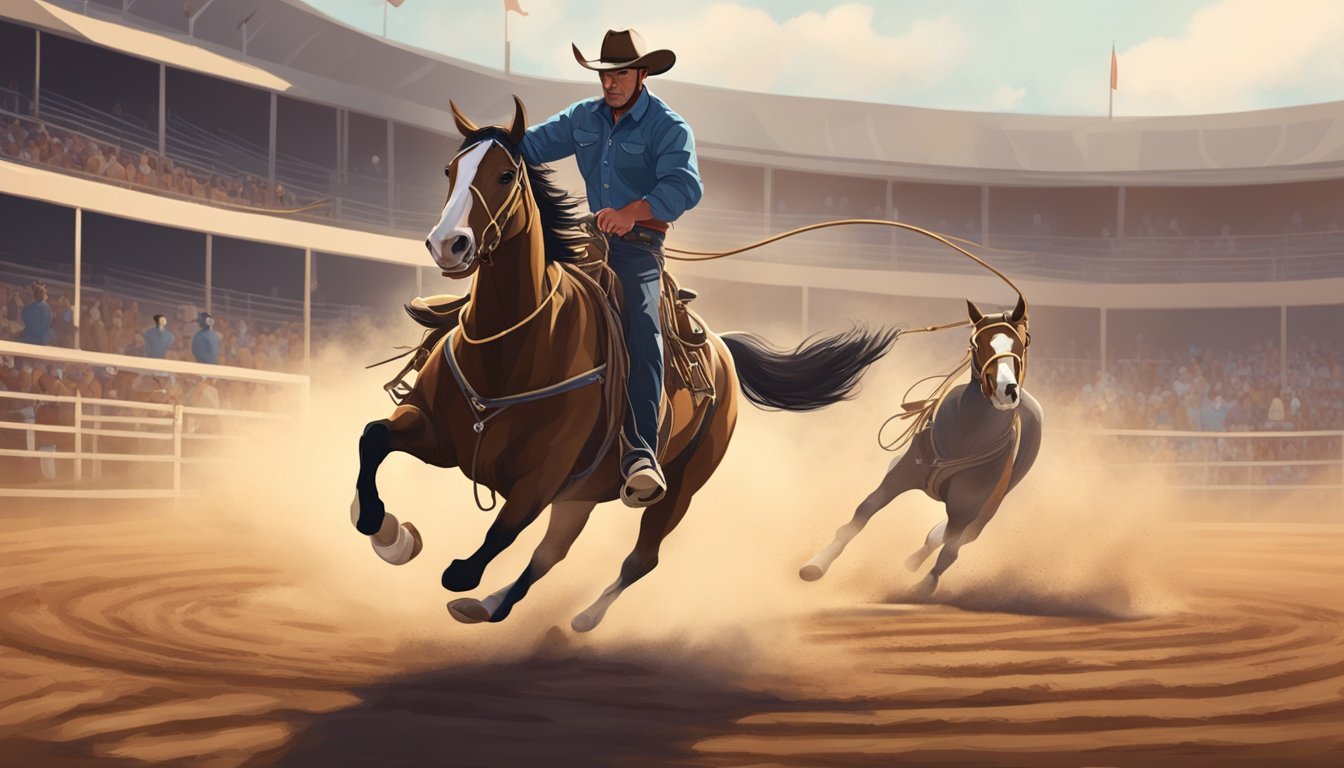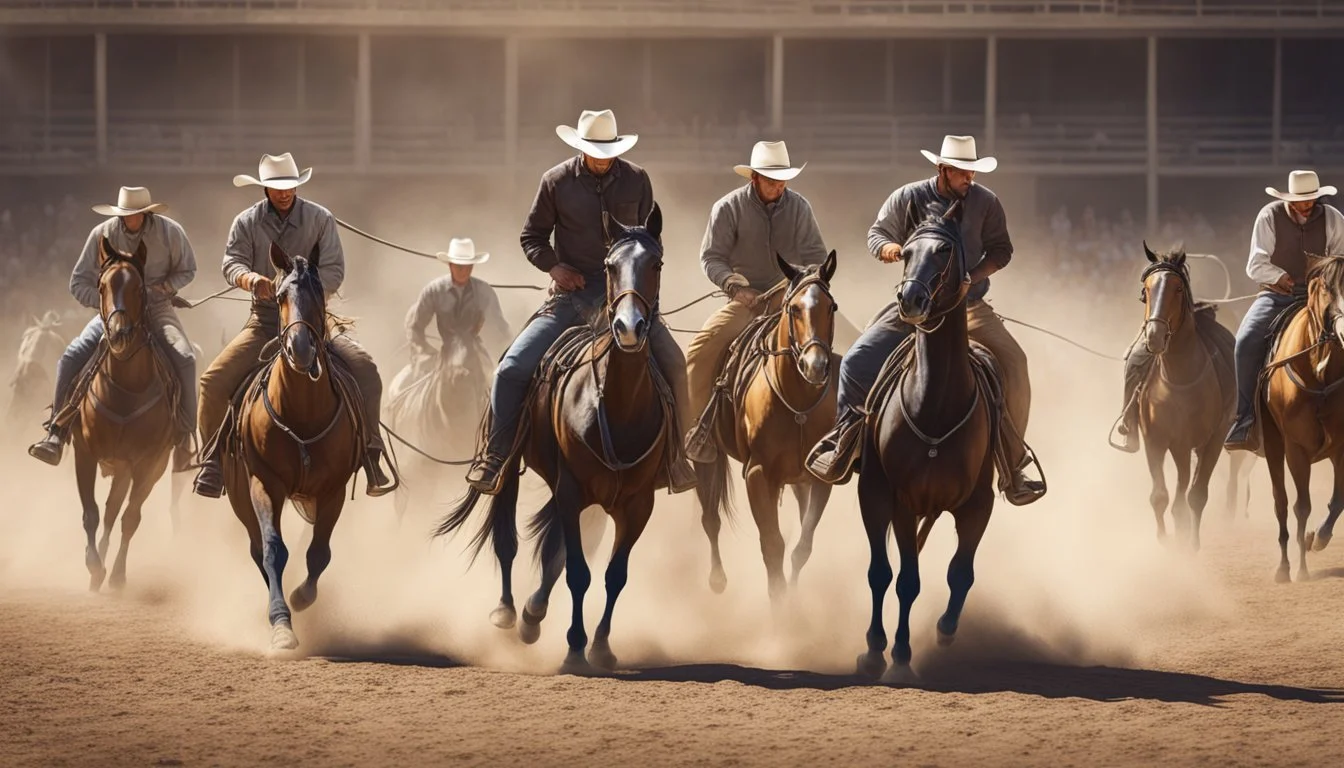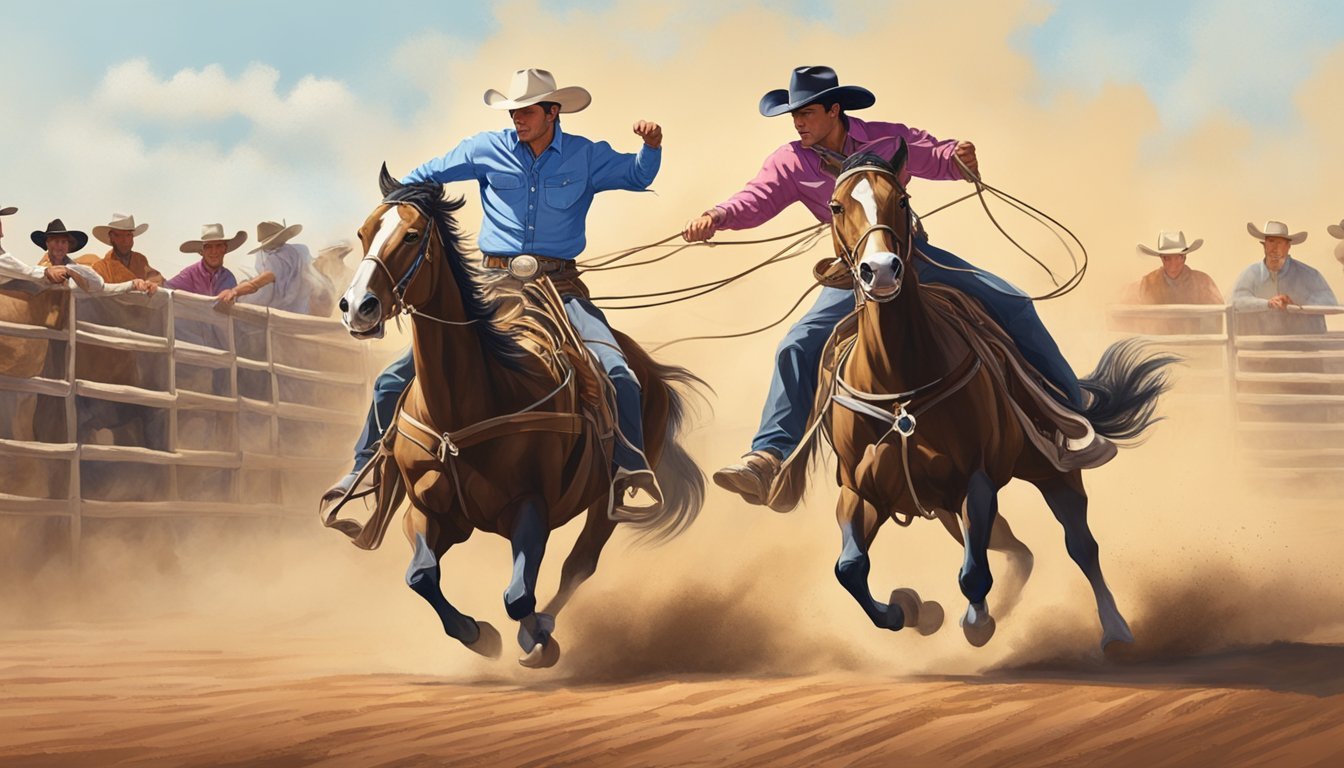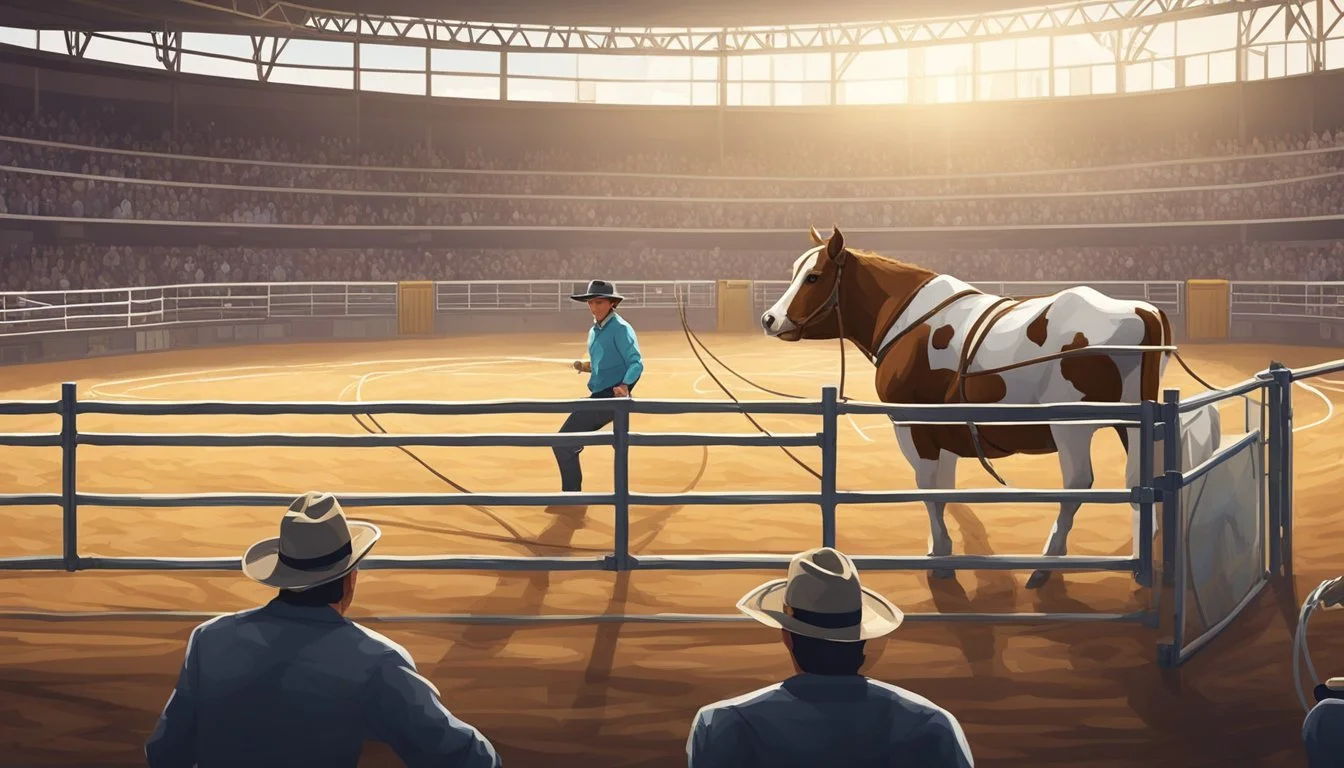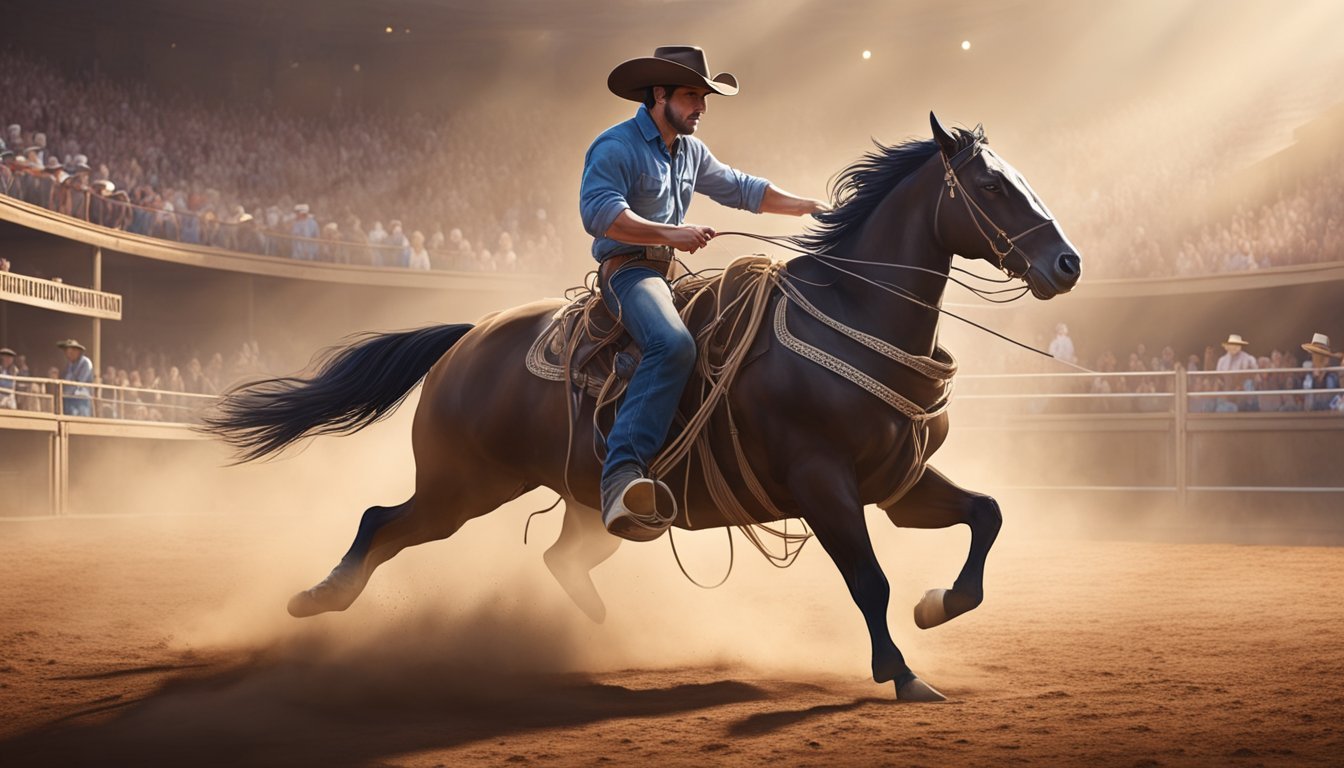The Basics of Roping
Mastering Essential Techniques and Entering Competitions
Roping is a traditional rodeo event that combines the agility and strength of both horse and rider. With origins deeply rooted in ranch work, where cowboys needed to capture and control cattle, it has evolved into a competitive sport that highlights the precision and teamwork required to rope a steer efficiently. There are several roping styles, but one of the most popular and recognized forms is team roping. In this discipline, two riders, known as the header and the heeler, work in tandem. The header is responsible for roping the steer’s head, while the heeler aims to rope the hind legs. The complexity of these roles makes the sport not just a demonstration of individual skill, but also of seamless cooperation between the riders and their horses.
In the arena of roping, the equipment utilized is as important as the skills of the participants. Ropers must select the appropriate gear, including ropes, saddles, and protective attire, to enhance their performance and ensure safety. The rope, made of durable materials capable of withstanding the demanding nature of the sport, is a roper’s primary tool. The correct selection and maintenance of a rope are critical, as it influences the grip and throw to effectively lasso the steer. Over the years, roping has expanded beyond the confines of traditional rodeo to include competitions that cater to various skill levels, from beginners to seasoned professionals, allowing for a wide audience to appreciate and engage in this compelling equestrian sport.
Understanding the fundamentals of roping is key for anyone looking to explore or excel in this area. Firm horsemanship, swift and precise lassoing, and a strong sense of timing are the cornerstones of successful roping. Competitors must also cultivate a deep connection with their horses, who are trained to anticipate and respond to the rapid maneuvers involved in the sport. With the right combination of skill, practice, and understanding, roping offers a uniquely challenging and rewarding experience for equestrian enthusiasts.
History and Evolution of Roping
Roping has a rich history deeply intertwined with Western cultural heritage and has evolved into a competitive sport with legends like Jake Barnes shaping it into what we see today at prestigious events such as the Ariat World Series of Team Roping Finale.
Roping's Roots in Western Culture
Roping began in the ranches of North America as a practical technique used by cowboys for capturing and handling cattle. Early vaqueros, the original Spanish cattle herders of Mexico, passed down the methods that would form the basis of the sport. In the 19th century, these skills transitioned from work to competition, embedding roping into the fabric of Western entertainment.
A significant aspect of its evolution into a competitive sport was influenced by the rodeo, wherein cowboys and cowgirls showcased their skills. The sport's progression is reflected in the tools and techniques cowboys use, which have been refined over the years for increased efficiency in both practical work and sporting events.
Influential Roping Competitions and Legends
Key competitions such as the Cinch National Finals of Team Roping and the Ariat World Series of Team Roping Finale have become platforms where rope artists vie for prestigious titles, substantial prize funds, and the chance to write their names in the annals of roping history.
Legends like Trevor Brazile, a household name, often dubbed the 'King of the Cowboys', has had a profound impact on the sport. Alongside him, Jake Barnes stands as a testament to the level of skill and dedication required to excel in roping competitions. These individuals have contributed to the ever-growing popularity and respect in the rodeo circuit and helped elevate roping from everyday ranch work to a respected western sport.
Understanding Roping Basics
Roping is an essential skill in various competitive events, requiring a nuanced understanding of techniques and specific terminology. Mastery of these fundamentals is critical for participants in rodeo sports.
Common Roping Terminology
Loop: The lasso's circular part, crafted to catch livestock.
Dally: A series of rapid wraps ropers make around their saddle horn after catching livestock.
Header: In team roping, the rider responsible for roping the steer's head.
Heeler: The team roping counterpart tasked with roping the steer's hind legs.
A solid grasp of the language used in roping helps competitors communicate effectively and understand the sport’s intricacies.
Types of Roping Events
Team Roping: A rodeo event involving two riders, the header and heeler, working in concert to catch a steer.
Header's goal: Rope the steer around the horns, neck, or a combination thereof.
Heeler's goal: Rope both of the steer's hind legs following the header's catch.
Tie-Down Roping: A timed event where a mounted rider chases and ropes a calf, then dismounts to restrain the animal by tying three legs together.
Breakaway Roping: Similar to tie-down roping, but the rope is not used to tie the calf; instead, it is attached to the saddle horn with a string that breaks free when the calf is caught, ending the event.
Each event requires its own set of roping skills and techniques, unique to that discipline but founded on the same principles of horsemanship and rope handling.
Getting Started with Roping
Roping is an equestrian sport that combines horsemanship with the skillful use of a lariat to catch livestock. For those new to this western tradition, starting with the right gear and a firm grasp of basic techniques is essential.
Selecting the Right Gear and Equipment
Proper gear is the cornerstone of success in roping. A beginner needs to choose the right type of rope suitable for their specific event, whether it's calf roping or team roping. Ropes differ in length, diameter, and material, with many ropers favoring a synthetic blend for its balance of weight and durability.
Equipment Description Importance Saddle A sturdy saddle designed for roping provides stability and helps in quick dismounts. Essential for control and comfort Gloves High-quality gloves protect the roper's hands from rope burns and improve grip. Critical for safety and performance Protective Gear Helmets and vests can offer protection during the event. Advised for safety
Additionally, having a well-trained horse that responds promptly to commands can significantly enhance a roper's performance. A quality saddle that ensures comfort and allows quick movements is also crucial.
Basic Roping Techniques and Skills
Roping demands precision, timing, and a strong foundational skill set. Practitioners must master the following core techniques:
The Swing: This involves creating consistent, even loops with the rope while maintaining rhythm and control.
The Delivery: When the roper throws the loop, aiming to encircle the target, it's essential to understand the animal's behavior and anticipate its movements.
Dallying: After catching the cattle, the roper must quickly wrap the rope around the saddle horn securely to ensure the catch is maintained without slipping.
Effective training sessions are key to honing one's technique. Practicing on a dummy target before attempting to rope live cattle is a safe and efficient way to improve. Observing and learning from experienced ropers, coupled with consistent practice, fosters skill development. Safety should always be prioritized, and the use of proper safety equipment cannot be overemphasized to mitigate the risks associated with roping.
The Role of Horses in Roping
In the equestrian sport of roping, horses are not just companions; they are integral participants that require careful selection, rigorous training, and expert handling by the rider to excel in the competition.
Horse Selection and Training
Selecting the right horse for roping is a critical first step. Competitors look for horses that are quick, agile, and have a calm demeanor to handle the high-pressure situations of a roping event. Training for roping competitions involves specialized exercises to develop the horse's strength, coordination, and response to a rider's cues.
Training includes:
Conditioning for quick sprints and abrupt stops.
Drills to fine-tune the horse's lateral movements and turns.
Familiarization with roping equipment, ensuring comfort with the feel of the rope and the saddle horn.
Horsemanship for Ropers
Expert horsemanship is fundamental to success in roping competitions. The rider must have a strong command of horseback riding skills and an in-depth understanding of the horse's behavior and body language. This connection allows for precise movements and communication between horse and rider, which is crucial when competing.
Key aspects of horsemanship for ropers:
Mastery of riding techniques for accurate positioning during roping.
Development of a symbiotic relationship allowing for subtle cueing and steer manipulation.
Knowledge of tack adjustments to optimize the horse's performance and comfort.
Roping Competition Structure
Roping competitions are governed by a set of rules and scoring systems designed to ensure fair play and determine the skill of the competitors. Being familiar with these structures is essential to prepare effectively for competition.
Understanding Scoring and Rules
In roping events, a team consists of two riders: the header and the heeler. The header's job is to rope the steer by the horns or neck, and the heeler aims to rope the steer's hind legs. Competitions are timed, and teams are scored on their speed and accuracy.
Scoring specifics include:
Catch: The header must make a legal catch on the steer—either a clean horn catch, a neck catch, or a half-head catch.
Time: The clock stops when both the header and heeler have made their catches and their horses face the steer with the ropes pulled tight.
Penalties: Teams incur penalties for infractions like roping only one hind leg by the heeler, which typically adds five seconds to the team's time.
Rules vary between events, but they often include:
A requirement that the heeler waits until the header has made the catch and turned the steer.
A barrier that the header must not break before the steer reaches a certain point, or they receive a penalty.
A limit on the number of throws permitted, often two.
Preparing for Competition
To prepare for roping competitions, competitors often engage in practice sessions to hone their skills. These sessions mimic the structure of the actual events and can range from one-on-one coaching to larger practice events, such as those held at futurities and at the National Finals Rodeo (NFR).
Practice session activities may include:
Simulated Competition Runs: Timed runs that replicate competition conditions.
Drills Focused on Technique: Exercises specific to headers or heelers to refine their throws and catches.
Horse Training: Ensuring that the horses are responsive and adept at the quick starts, turns, and stops required.
A well-rounded preparation regime is critical for ropers aiming to excel in competitions. Under the pressure of competition, a team's coordination and the training level of their horses are as scrutinized as their personal skill, and all must work in concert to secure success.
Advanced Roping Techniques
Advancing in the sport of roping necessitates a mastery of intricate techniques and positions, especially for team ropers who must perfect their roles as a header and heeler. This section breaks down the nuanced skills required for both positions and explores how ropers can elevate their performance from practice to the rodeo arena.
Mastering Team Roping Positions
In team roping, the header is responsible for roping the steer by its horns, head, or neck, and the heeler follows up by roping the steer's hind legs. Advanced headers fine-tune their swing to maintain a consistent loop size and form, ensuring a precise catch. For heelers, positioning is critical; they must ride in sync with the steer to time their throw perfectly.
Key Points for Headers:
Maintain a balanced position on the horse for effective throws.
Develop a smooth and controlled swing for catching the steer.
Form should be honed for quick and accurate loop placement.
Key Points for Heelers:
Perfect the art of positioning to anticipate the steer's movement.
Practice the dally – wrapping the rope around the saddle horn after a catch.
Hone skills in flanking the steer effectively, as this can save valuable seconds.
Skill Building: From Practice to Performance
To transition from practice to performance, team ropers must consistently work on their skills, focusing on muscle memory and reflexes. Advanced techniques such as flanking the calf rapidly after roping, and tying a quick hooey, the knot used to secure the calf's legs in tie-down roping, are essential for reducing time during competitions.
Headers should focus on:
Position practice to always align with the steer.
Improved rope handling for effective loop form and quick catches.
Heelers need to concentrate on:
Precise timing to match the steer's pace and position for successful heeling.
Practicing the dally, ensuring it's tight and secure, reducing the chance of rope slips or burns.
Through meticulous practice and understanding of these advanced roping techniques, team ropers can greatly enhance their effectiveness in the competition, leading to better performances and potentially, more wins.
Notable Ropers and Horses
Notable ropers and their equine partners have significantly shaped the world of rodeo, displaying exceptional skill and earning considerable accolades.
Profiles of Roping Champions
Matt Sherwood
Matt Sherwood has made his mark in the world of team roping as a multiple-time world champion. His precision and expertise in the header position have earned him top honors and recognition in professional circles.Ryan Motes
A heeler known for his quick hands and consistency, Ryan Motes has competed at the highest levels. His accolades include numerous championships that showcase his dedication to the sport.Miles Baker
Miles Baker, though less known than some, has shown promise in the roping arena. His growing reputation is one to watch as he continues to compete and hone his skills.Clay Cooper
Known as one of the legends of roping, Clay Cooper's influence on the sport is undeniable. His numerous championship titles and the incredible finesse he exhibits as a heeler have set a benchmark in team roping.Lari Dee Guy
As a pioneering woman in the sport, Lari Dee Guy has broken barriers and set records. Her achievements have inspired many, and her role as an ambassador of the sport is unparalleled.JJ Hampton
JJ Hampton has an exceptional record, her prowess in roping has secured her multiple championships. She continues to be a fierce competitor in the rodeo arena.Caleb Smidt
A competitor known for his versatility, Caleb Smidt has gained recognition as a world-class roper. His victories in multiple events speak to his comprehensive skill set and adaptability.
Famous Competition Horses
Relentless Remuda The horses from the Relentless Remuda breeding program have become synonymous with quality in team roping. Originating from a line of carefully selected and trained horses, they have carried ropers to significant victories.
Name of Horse Roper Associated Achievements Marty Clay Smith Noted for helping top headers like Clay Smith in championship wins. Captain Brenten Hall A pinto horse known for being part of the mix at National Finals Rodeo events. Cruiser Brady Minor This grade horse has displayed exceptional agility and responsiveness in competitions. Ima Fresnos Dee Cody Snow A mare that has broken convention, excelling in the heading position at national competitions.
These individuals and their horses represent the pinnacle of roping skill and serve as inspirations and role models for upcoming generations in the sport.
Improving Your Roping Experience
To truly excel in the roping arena, enthusiasts need to focus on rigorous training, subjective coordination, and precise timing. Leverage a range of resources and a community of experts to enhance the learning curve.
Training and Conditioning Strategies
Effective Practice Sessions: Structured practice sessions are pivotal for ropers at all levels. Regular training helps in honing coordination, which is critical to ensure that the horse and roper work seamlessly as a unit. A noteworthy approach includes the Driven 2.0 method, focusing on incremental improvement and building upon the basics to achieve the perfect spin and throw.
Mental and Physical Preparedness: Besides physical practice, mental conditioning cannot be overstated. A roper should visualize the motions and scenarios, contributing to a roping experience where precise timing becomes second nature.
Community and Learning Resources
Educational Platforms: Access to a platform like Roping.com offers a multitude of educational resources. Members can indulge in a wide array of exclusive content ranging from beginner tips to advanced tactics provided by seasoned experts, enhancing both knowledge and practice.
Livestream Sessions: Engaging with live online events gives learners the ability to witness professional techniques in real-time. These livestream sessions not only offer visual learning but also give immediate access to guidance and strategies that viewers can apply in their next practice session.
By strategically combining regular, targeted practice with the rich resources available through a supportive community, ropers can experience significant improvements in their sport.
Roping as a Spectator Sport
Roping events offer a unique blend of athletic skill and competitive excitement, drawing spectators to witness the partnership between rider and horse in fast-paced rodeo activities.
Attending Roping Events and Competitions
Team roping competitions such as the Ariat World Series of Team Roping and the USTRC's Cinch National Finals of Team Roping attract spectators from various regions, showcasing high levels of horsemanship and coordination. Notable events like the Cinch Timed Event Championship, Riata Buckle, and the Lonestar Shootout are key fixtures in the roping arena, presenting an exceptional display of this skilled sport.
Ariat World Series of Team Roping: This series represents one of the largest team roping organizations, where headers and heelers compete for significant prize money.
Cinch Timed Event Championship: A true test of versatility, this event sees competitors perform in multiple timed events, not just team roping.
Riata Buckle and Lonestar Shootout: These competitions bring together some of the best roping talent, offering impressive spectacles for fans and considerable rewards for contestants.
Understanding the Spectator Experience
Spectators at roping events are treated to a dynamic showcase of agility and teamwork. In team roping, one can observe the synergy between the "header" who ropes the steer by its horns, and the "heeler" who latches onto its hind legs. The excitement builds as they aim to accomplish this task in the shortest time possible.
Observation Tips:
Pay attention to the horse's athleticism and the rider's precision.
Note the efficiency of the team's collaboration, crucial for a winning run.
Spectators should also look out for the scoring system, understanding how penalties can affect competitors' standings. Whether one is a seasoned fan or a first-time attendee, they will quickly find themselves engrossed in the action within the arena as riders and their horses strive for excellence in this captivating sport.
Roping Safety and Animal Welfare
In the world of roping, the safety of both human and animal participants takes precedence, with a range of measures in place to mitigate risks and uphold ethical treatment.
Safety Measures for Ropers and Horses
Ropers and their horses are exposed to various physical dangers during roping events. To minimize these risks, strict guidelines and use of protective gear are enforced. Ropers typically wear helmets and protective vests to guard against falls and kicks. Horses are often outfitted with boots to support their legs and prevent injuries.
Specific rules govern how riders handle their lasso, ensuring that the rope is thrown accurately and safely. Moreover, training for both ropers and horses is fundamental, emphasizing the correct techniques and methods to perform without harming themselves or the calves.
Ethical Considerations in Roping
Animal welfare is a central aspect of modern roping competitions. Organizers must ensure that animals are treated humanely, and their well-being is always considered. For calves, the sport has evolved to include breakaway lassos that prevent prolonged constraint and stress. This shift demonstrates an acknowledgment of the animal's wellness and a movement towards more ethical practices.
Stringent regulations determine how calves are handled during events, focusing on reducing distress and avoiding any potential physical injury. Vets are typically on-site to provide immediate care if needed, illustrating a commitment to responsible animal care in the sport of roping.
Fostering the Future of Roping
Roping, as a sport and skill, remains vibrant through the continuous engagement with youth and the embrace of innovation. It's essential for the community to nurture new talent and apply advanced techniques to uphold the sport's legacy.
Youth Engagement and Training
The future of roping hinges on the active participation and training of young enthusiasts. Rodeo schools and camps are primary avenues where youth can learn the fundamentals of roping from experienced cowboys and cowgirls. Structured learning environments offer:
Hands-On Techniques: Young ropers acquire skills such as loop placement and timing.
Horse Handling: They learn the importance of selecting the right horse and developing a bond.
Competitions, such as youth rodeos and futurities, play a critical role. They provide platforms for young ropers to showcase their skills and gain experience in a competitive setting. Moreover, these events inspire youth involvement by displaying the possibilities within the sport.
Innovation and the Future of the Sport
Innovation in roping extends beyond physical techniques to include advancements in tack and training methods. Rodeo futurities contribute to this innovation by integrating a structured process that aids in early development of competition horses. These processes impact the sport by:
Evolving Gear: Introducing materials that enhance rope handling and durability.
Training Techniques: Utilizing video analysis and other technologies for performance improvement.
Team roping specifically benefits from innovation; for example, the introduction of safer and more efficient lariats helps ropers perform better, while also prioritizing the welfare of the livestock involved. As enthusiasts and professionals adopt new methods, roping continues to evolve, ensuring its endurance and relevance in the future of Western sports and culture.

